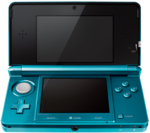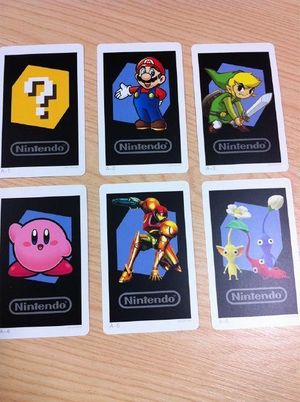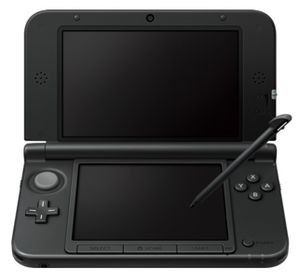| Site Notice |
|---|
|
We have a limited coverage policy. Please check our coverage page to see which articles are allowed. |
Difference between revisions of "Nintendo 3DS"
PokeCaptain (talk | contribs) (Updated list of 3DS firmware revisions to 10.5.0-30) |
m |
||
| Line 35: | Line 35: | ||
* KR: | * KR: | ||
}} | }} | ||
| − | |||
The '''Nintendo 3DS''' (Japanese: '''ニンテンド3DS''' ''Nintendo 3DS'') is a portable console developed by [[Nintendo]]. It is the successor of the [[Nintendo DS]]. Like previous DS consoles, it features dual screens, with the lower screen being a touch screen. However, the top screen is able to produce "3D effects without glasses" via a process called [[wikipedia:autostereoscopy|autostereoscopy]]. The console features backwards compatiblity with the DS and DSi consoles. It was released on February 25, 2011 for Japan, March 27, 2011 for North America. It also has a Mii Maker, and a Virtual Console for [[Game Boy]] and [[Game Boy Color]] games. | The '''Nintendo 3DS''' (Japanese: '''ニンテンド3DS''' ''Nintendo 3DS'') is a portable console developed by [[Nintendo]]. It is the successor of the [[Nintendo DS]]. Like previous DS consoles, it features dual screens, with the lower screen being a touch screen. However, the top screen is able to produce "3D effects without glasses" via a process called [[wikipedia:autostereoscopy|autostereoscopy]]. The console features backwards compatiblity with the DS and DSi consoles. It was released on February 25, 2011 for Japan, March 27, 2011 for North America. It also has a Mii Maker, and a Virtual Console for [[Game Boy]] and [[Game Boy Color]] games. | ||
| − | |||
==Features and Software== | ==Features and Software== | ||
| − | === System Settings === | + | ===System Settings=== |
System Settings allows you to change settings for your Nintendo 3DS, such as system profile and date/time. System Settings also allows you to calibrate the touch screen and Circle Pad, perform Microphone Tests and 3D Screen Checks, and use System Transfer. | System Settings allows you to change settings for your Nintendo 3DS, such as system profile and date/time. System Settings also allows you to calibrate the touch screen and Circle Pad, perform Microphone Tests and 3D Screen Checks, and use System Transfer. | ||
| − | === Activity Log === | + | ===Activity Log=== |
Activity Log allows you to view records of activity on the 3DS (pedometer steps, game playtime, etc.). It also has a Software Library feature where you can view software you've played, how long you've played it, etc. You can also view rankings in the Software Library. | Activity Log allows you to view records of activity on the 3DS (pedometer steps, game playtime, etc.). It also has a Software Library feature where you can view software you've played, how long you've played it, etc. You can also view rankings in the Software Library. | ||
| − | === AR Games === | + | ===AR Games=== |
[[File:3DSARcard.jpg|right|thumb|AR Cards]] | [[File:3DSARcard.jpg|right|thumb|AR Cards]] | ||
'''Augmented Realty Games''' (or '''AR Games''' for short) are games that use the AR cards and the 2 outer cameras to augment reality on your 3DS screen. You can then play a multitude of games such as archery and fishing. You can also use your play coins to purchase new games. | '''Augmented Realty Games''' (or '''AR Games''' for short) are games that use the AR cards and the 2 outer cameras to augment reality on your 3DS screen. You can then play a multitude of games such as archery and fishing. You can also use your play coins to purchase new games. | ||
| − | === Nintendo eShop === | + | ===Nintendo eShop=== |
The 3DS features its own video game and application download feature called the '''Nintendo eShop''', which features games from the [[Game Boy]], [[Game Boy Color]], as well as 3D versions of "Classic Games", in addition to DSiware games.<ref>{{cite-web|name=Nintendo|site= Nintendo.com|adress=[http://www.nintendo.com/3ds/built-in-software/#/7 Nintendo 3DS - Built in Software and Applications]|year=2011|title = Nintendo 3DS - Built in Software and Applications|accessed = August 9th, 2011}}</ref> The Nintendo eShop abandons the traditional Nintendo points system and instead use a cash-based system where people can either load money onto their 3DS directly with a credit card or through official cards bought in retail stores.<ref>{{cite-web|site=Nintendo life|adress=[http://3ds.nintendolife.com/news/2011/02/current_nintendo_points_will_be_useless_on_the_3ds Current Nintendo Points will be Useless on the 3DS]|year=2011|title = Current Nintendo Points will be Useless on the 3DS|accessed = August 9th, 2011}}</ref> | The 3DS features its own video game and application download feature called the '''Nintendo eShop''', which features games from the [[Game Boy]], [[Game Boy Color]], as well as 3D versions of "Classic Games", in addition to DSiware games.<ref>{{cite-web|name=Nintendo|site= Nintendo.com|adress=[http://www.nintendo.com/3ds/built-in-software/#/7 Nintendo 3DS - Built in Software and Applications]|year=2011|title = Nintendo 3DS - Built in Software and Applications|accessed = August 9th, 2011}}</ref> The Nintendo eShop abandons the traditional Nintendo points system and instead use a cash-based system where people can either load money onto their 3DS directly with a credit card or through official cards bought in retail stores.<ref>{{cite-web|site=Nintendo life|adress=[http://3ds.nintendolife.com/news/2011/02/current_nintendo_points_will_be_useless_on_the_3ds Current Nintendo Points will be Useless on the 3DS]|year=2011|title = Current Nintendo Points will be Useless on the 3DS|accessed = August 9th, 2011}}</ref> | ||
| Line 243: | Line 241: | ||
|January 25, 2016 | |January 25, 2016 | ||
|Stability fixes and minor adjustments. | |Stability fixes and minor adjustments. | ||
| − | |-} | + | |- |
| + | |} | ||
==System revisions== | ==System revisions== | ||
| Line 269: | Line 268: | ||
</div> | </div> | ||
| − | == External links == | + | ==External links== |
| − | + | *{{wp|Nintendo 3DS|''Nintendo 3DS'' on Wikipedia}} | |
| − | + | *{{sw|Category:Nintendo 3DS|''Nintendo 3DS'' on StrategyWiki}} | |
| − | + | *{{bp|Nintendo 3DS|''Nintendo 3DS'' on Bulbapedia}} | |
| − | + | *{{smw|Nintendo 3DS|''Nintendo 3DS'' on Super Mario Wiki}} | |
| + | *{{zw|Nintendo 3DS|''Nintendo 3DS'' on Zelda Wiki}} | ||
| + | *{{ssb|Nintendo 3DS|''Nintendo 3DS'' on SmashWiki}} | ||
{{stub}} | {{stub}} | ||
Revision as of 14:49, 16 February 2016
| Nintendo 3DS ニンテンドー3DS Nintendō Surī Dī Esu | ||||||||||
| ||||||||||
| ||||||||||
| ||||||||||
| ||||||||||
| ||||||||||
|
The Nintendo 3DS (Japanese: ニンテンド3DS Nintendo 3DS) is a portable console developed by Nintendo. It is the successor of the Nintendo DS. Like previous DS consoles, it features dual screens, with the lower screen being a touch screen. However, the top screen is able to produce "3D effects without glasses" via a process called autostereoscopy. The console features backwards compatiblity with the DS and DSi consoles. It was released on February 25, 2011 for Japan, March 27, 2011 for North America. It also has a Mii Maker, and a Virtual Console for Game Boy and Game Boy Color games.
Contents
Features and Software
System Settings
System Settings allows you to change settings for your Nintendo 3DS, such as system profile and date/time. System Settings also allows you to calibrate the touch screen and Circle Pad, perform Microphone Tests and 3D Screen Checks, and use System Transfer.
Activity Log
Activity Log allows you to view records of activity on the 3DS (pedometer steps, game playtime, etc.). It also has a Software Library feature where you can view software you've played, how long you've played it, etc. You can also view rankings in the Software Library.
AR Games
Augmented Realty Games (or AR Games for short) are games that use the AR cards and the 2 outer cameras to augment reality on your 3DS screen. You can then play a multitude of games such as archery and fishing. You can also use your play coins to purchase new games.
Nintendo eShop
The 3DS features its own video game and application download feature called the Nintendo eShop, which features games from the Game Boy, Game Boy Color, as well as 3D versions of "Classic Games", in addition to DSiware games.[1] The Nintendo eShop abandons the traditional Nintendo points system and instead use a cash-based system where people can either load money onto their 3DS directly with a credit card or through official cards bought in retail stores.[2]
Themes
| Main article: List of Nintendo 3DS themes |
The October 6, 2014 update added themes to the HOME Menu. Five come free (red, blue, yellow, pink, and black) and a Theme Shop has more for purchase.
List of Nintendo 3DS System Versions
| Version Number | Date Released | Description |
|---|---|---|
| 1.0.0-0 | System Default | Initial version included at the launch of the system. |
| 1.1.0-1 | March 27, 2011 | Improves stability of system, improves network connectivity, and extends data receiving ability. Also adds a 3D demonstration video. |
| 2.0.0-2 | June 6, 2011 | Adds Nintendo eShop, 3DS Internet Browser, DSi-3DS system transfer, and SpotPass functionality in Sleep Mode. Also introduces a bug in Ridge Racer 3D. |
| 2.1.0-3 | June 15, 2011 | Adds automatic updating when a wireless internet connection is available. Also fixes Ridge Racer 3D bug. |
| 2.1.0-4 | July 25, 2011 | System stability fixes. |
| 2.2.0-4 | November 13, 2011 | Adds ability to join online games from Friend List. Required to run Super Mario 3D Land and Mario Kart 7, and will automatically update to this version if a 3DS is not updated to this version or later. |
| 3.0.0-5 | December 6, 2011 | Adds 3D video recording and stop motion/time lapse functionality to 3DS Camera. Adds Accomplishments, Music Player, Slideshow (for finished Puzzle Swap panels), SpotPass functionality, improved StreetPass functionality, new Puzzle Swap panels, and Find Mii II to StreetPass Mii Plaza. Adds demo downloads, in-game purchase downloads, Sleep Mode downloads ("Download Later"), add-on content for cartridge games, and improved convienience to Nintendo eShop. Improves Parental Controls, system security, and online play. Adds 3DS-3DS System Transfer, QR Code functionality (in HOME Menu's camera mode), and Nintendo Zone. |
| 3.0.0-6 | December 21, 2011 | Minor improvements to system performance and StreetPass Mii Plaza. |
| 4.0.0-7 | April 24, 2012 | Adds ability to create folders on the Home Menu to organize games and applications. |
| 4.1.0-8 | May 14, 2012 | System stability fixes and minor adjustments |
| 4.2.0-9 | June 26, 2012 | System stability fixes and minor adjustments |
| 4.3.0-10 | July 24, 2012 | System stability foxes and minor adjustments |
| 4.4.0-10 | September 19, 2012 | System stability fixes and minor adjustments |
| 4.5.0-10 | December 4, 2012 | System stability fixes and minor adjustments |
| 5.0.0-11 | March 25, 2013 | Makes Sleep Mode downloads still function when Nintendo eShop is open while in Sleep Mode |
| 5.1.0-11 | April 4, 2013 | Fixes bug that prevents accessing System Settings |
| 6.0.0-11 | June 17, 2013 | Adds save data backups for downloaded games |
| 6.1.0-11 | June 27, 2013 | System stability fixes and minor adjustments |
| 6.1.0-12 | July 11, 2013 | Can now update StreetPass Mii Plaza from within Mii Plaza application |
| 6.2.0-12 | August 5, 2013 | Adds StreetPass relay feature, allowing StreetPass data to be passed between systems within a Nintendo Zone |
| 6.3.0-12 | September 12, 2013 | System stability fixes and minor adjustments |
| 7.0.0-13 | December 9, 2013 | Adds Nintendo Network IDs, Miiverse, and a notification system for software updates. Changes activation of the 3DS Camera to pressing the L and R buttons simultaneously. Removed limit of system transfers |
| 7.1.0-14 | December 19, 2013 | System stability fixes and minor adjustments |
| 7.1.0-15 | January 22, 2014 | System stability fixes and minor adjustments |
| 7.1.0-16 | February 26, 2014 | System stability fixes and minor adjustments |
| 7.2.0-17 | May 12, 2014 | Passwords for Parental Controls may now be emailed in case they are forgotten |
| 8.0.0-18 | July 7, 2014 | System stability fixes and minor adjustments |
| 8.1.0-18 | July 24, 2014 | System stability fixes and minor adjustments |
| 8.1.0-19 | August 6, 2014 | System stability fixes and minor adjustments |
| 9.0.0-20 | October 6, 2014 | Adds themes to the Home Menu and a Theme Shop for purchaseable ones. Screenshots of the Home Menu are now possible. Alteration to the Nintendo eShop. |
| 9.2.0-20 | October 29, 2014 | System stability fixes and minor adjustments |
| 9.3.0-21 | December 8, 2014 | Users are now able to shuffle through themes, software updates downloadable on the HOME menu, screenshots now available for both screens, amiibo settings for the 3DS XL, and stability improvements. |
| 9.4.0-21 | December 11, 2014 | System stability fixes and minor adjustments. |
| 9.5.0-22 | February 2, 2015 | System stability fixes and minor adjustments. |
| 9.5.0-23 | March 2, 2015 | System stability fixes and minor adjustments. |
| 9.6.0-24 | March 23, 2015 | Home menu layout setting, additional theme categories, stability fixes and minor adjustments added. Amiibo settings for most devices also added. |
| 9.7.0-25 | April 20, 2015 | System stability fixes and minor adjustments. |
| 9.8.0-25 | June 1, 2015 | System stability fixes and minor adjustments. |
| 9.9.0-26 | July 13, 2015 | System stability fixes, security stability, and minor adjustments. |
| 10.0.0-27 | September 8, 2015 | System stability fixes and minor adjustments. |
| 10.1.0-27 | September 14, 2015 | System stability fixes and minor adjustments. |
| 10.2.0-28 | October 19, 2015 | System stability fixes and minor adjustments. |
| 10.3.0-28 | November 9, 2015 | Stability fixes and minor adjustments. |
| 10.4.0-29 | January 18, 2016 | Stability fixes and minor adjustments. |
| 10.5.0-30 | January 25, 2016 | Stability fixes and minor adjustments. |
System revisions
Nintendo 3DS XL
In July 2012, a second iteration of the console was released, the Nintendo 3DS XL. It was released in North America and Europe in Silver/Brown, Red/Brown and Blue/Brown colours, and was also released in fully white and Pikachu-themed editions in Japan.
Differences between the Nintendo 3DS and 3DS XL
- The 3DS XL boasts 90% bigger screens, which also results in a harder to lose 3D sweetspot, and more exaggerated 3D effect. The screens are also les light-reflective.
- The 3DS XL has a larger battery life.
- The 3D light has been removed, and the 3D Slider must now be clicked to be disabled.
- Start, Select and Home are now more clickable buttons.
- The 3DS XL comes with a larger SD Card.
- The stylus of the 3DS XL is no longer telescopic, and is placed in the side of the console.
- The circle pad is smaller, smoother, and indented further into the console. Additionally, the four protrusions of the D-Pad are now sloped.
Nintendo 2DS
The Nintendo 2DS is the third version of the Nintendo 3DS hardware, released on October 12, 2013 for most of the world (coinciding with the release of Pokémon X and Y, and on December 7, 2013 in South Korea; the hardware has not been released in Japan. The Nintendo 2DS was designed to be an entry-level and budget version of the console, having a cheaper price point compared to the other two systems at the time and removing several features, most notably the stereoscopic 3D capabilities of the system; as such, according to Reggie Fils-Aimé the target audience of the Nintendo 2DS is younger players who were advised to not use the 3D feature on the standard Nintendo 3DS and Nintendo 3DS XL systems.
While the system's internals and software capabilities are the same as the Nintendo 3DS as it is redesign of the system, several alterations were made to cut costs. While the system lacks the 3D capabilities of the other systems, it still has the dual cameras allowing it to capture 3D images, which can be viewed in 3D on any other Nintendo 3DS family system. In addition, the Nintendo 2DS uses a new form factor rather than the clamshell form used by all Nintendo handheld systems since the Game Boy Advance SP (excluding the Game Boy Micro); the system instead has a switch for putting the system into sleep mode. The dual screens are a singular touch-sensitive screen framed to give the illusion of dual screens and to retain the same dimensions as other Nintendo 3DS systems. It also only has mono audio output as opposed to the stereo output of the previous systems. Finally, the Start and Select buttons are placed on the bottom right side of the system, as opposed to being on both sides of the home button, while the other buttons themselves are placed closer to the center of the system due to the new design.
References
- ↑ Nintendo.com. 2011. "Nintendo 3DS - Built in Software and Applications". Accessed August 9th, 2011. Nintendo 3DS - Built in Software and Applications.
- ↑ Nintendo life. 2011. "Current Nintendo Points will be Useless on the 3DS". Accessed August 9th, 2011. Current Nintendo Points will be Useless on the 3DS.
- ↑ Nintendo.com. 2014. "Nintendo 3DS - System Menu Update History". Accessed October 29th, 2014. Nintendo 3DS - System Menu Update History.
External links
- Nintendo 3DS on Wikipedia
- Nintendo 3DS on StrategyWiki
- Nintendo 3DS on Bulbapedia
- Nintendo 3DS on Super Mario Wiki
- Nintendo 3DS on Zelda Wiki
- Nintendo 3DS on SmashWiki
| This article is a stub. You can help NintendoWiki by expanding it. |
| |||||||||||||||||||||
| |||||||||||||||||||||
| |||||||||||||||||||||




